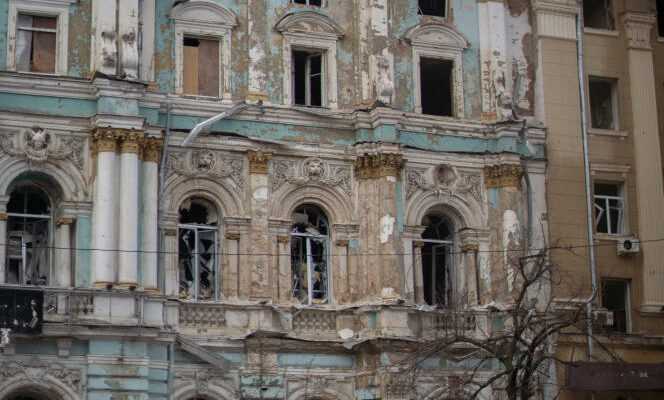How will Ukrainian heritage survive the war? What remains of it today, when a number of cities are under heavy bombardment? For Bohdan Cherkes, director of the Institute of Architecture and Design at the National Polytechnic University of Lviv, the ongoing disaster is comparable to that committed by the Nazis who, during the Second World War, destroyed a considerable part of the heritage of many cities. Reached by telephone in Poland, where he is a refugee, he particularly mourns Kharkiv, this city which was the capital of Soviet Ukraine from 1917 to 1934 and “which brings together the finest specimens of constructivist architecture of the 1920s from all over the USSR, and even from all of Eastern Europe”.
With its thirteen-storey tower, considered the first European skyscraper, the gigantic Gosprom complex (built by architects Sergei Serafimov, Samuel Kravets, Mark Felger and engineer Pavel Rottert in 1928) is one of the most famous. Another is the Railway Workers’ Palace of Culture (Alexandr Dmitriev, 1932), a fantastic Art Deco building with convex curves. “All this modern architecture was built collectively by Russians, Ukrainians and Jews. That Russians destroy our common heritage in this way is for me an absolute heartbreak. »
In Kharkiv, as of April 2, 1,500 buildings had been destroyed or damaged, according to the mayor of the city, who specified that 15% of the housing stock had disappeared. Among the buildings of high heritage value known to have been affected are the Karazin National University, a glorious modernist complex built by the engineer Kushnarev in 1925, as well as the Church of the Holy Eternal Sleep, whose construction s is spread between the XVIIand and the 19thand century.
With the help of a small team of Ukrainian architects, academics and students based in Lviv, the French architect Martin Duplantier, president of the association Architecture et maîtres d’ouvrage (AMO), set out in a nationwide destruction mapping operation. Cross-checking information from official sources with that which they manage to glean from correspondents who remained in the war zones and from social networks, they update, as best they can, a general count of the destruction, and analyze in a more detailed the situation of five cities – Kharkiv, Mariupol, Tchernihiv, Mykolaiv and Sumy – chosen both for the value of their heritage and for the extent of the destruction they have suffered. Their work should be published soon on the AMO website, which is still awaiting the green light from the French Ministry of Defense to map the results.
You have 63.93% of this article left to read. The following is for subscribers only.
